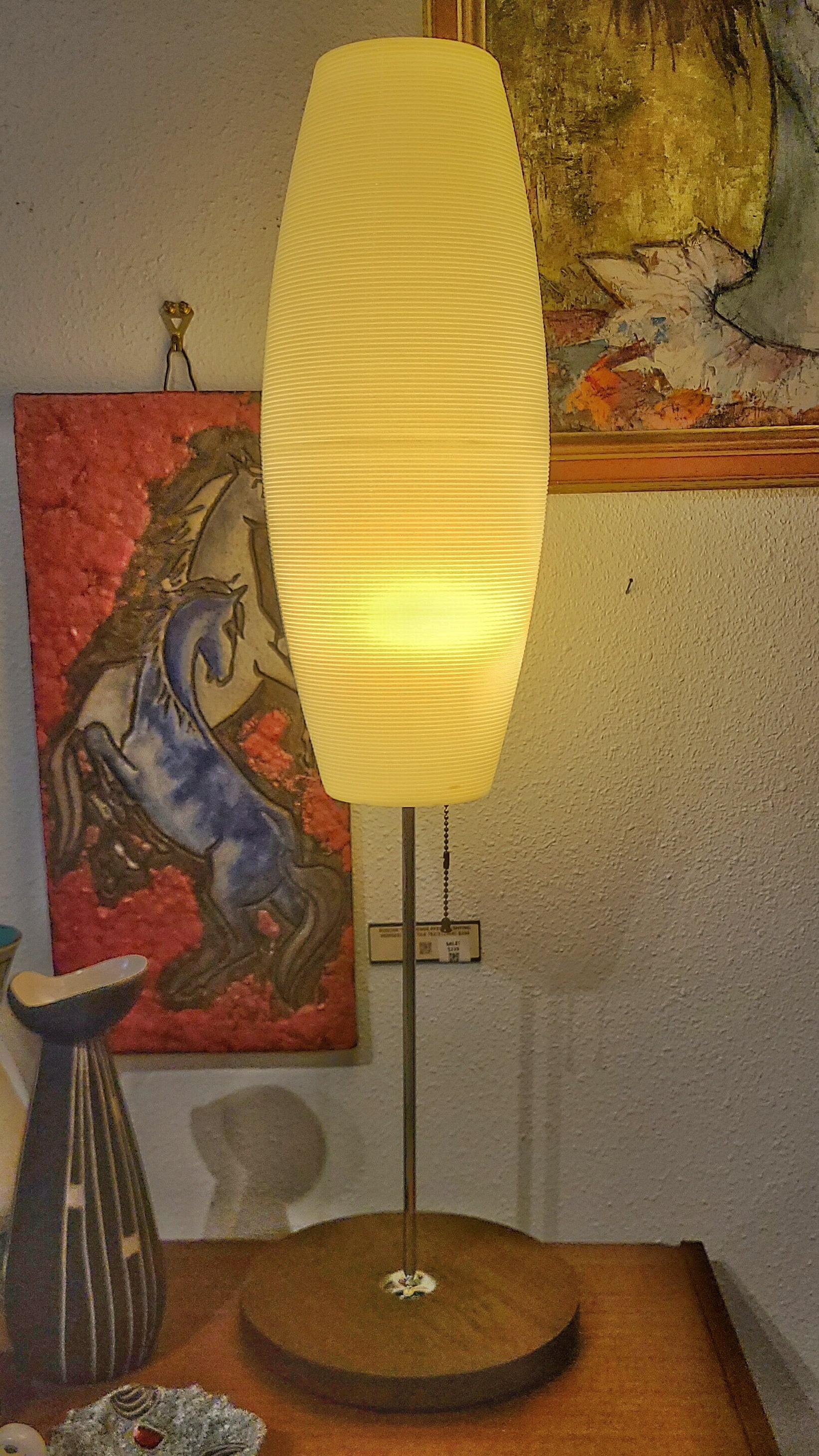
YASHA HEIFETZ ‘ROTAFLEX’ TABLE LAMP
CONTACT US HERE ABOUT THIS ITEM.
Beautifully simple tall table lamp designed by Yasha Heifetz for the ‘Rotaflex’ line. Constructed of a solid walnut base with chromed steel hardware and a coiled cellulose acetate shade. Overall in very good condition.
ROTAFLEX™ is the name of a patented method of spinning cellulose acetate 'yarn' into a lampshade. The patent filed in 1946 by Danish civil engineers Bent Højberg Pedersen and Bent Panker, describes the process by which a thermoplastic bioplastic cord is spun on a mold by hand while an acetone mixture is brushed on as the mold spins. Cellulose acetate is an early acrylic with various trade names, known as Rhodoid in France and the UK, Tenite in the US, and Cellon in Germany. Cellulose acetate is lighter than glass, less fragile than paper, and it allows a great variety of shapes in many colors at a reasonable price; moreover, it gives a beautiful light.
The fabulous world of Rotaflex lamps can be quite confusing since The term 'Rotaflex' designates not only the material patented by Bent H. Pedersen (“Rotaflex lamp”), the diffusers thus produced (“base surmounted by a Rotaflex”), but also the name of the British brand founded in 1953 by Bernard Stern (Rotaflex LTD), and several companies and brands that all developed in quick succession and are interconnected via licensing. The Rotaflex process makes it possible to produce objects (essentially related to the field of lighting) by winding cellulose acetate yarn around a support – the shape of which the unmolded object will retain. Several elements can be glued to create cylindrical, ovoid, elliptical, or complex-shaped parts.
The first lamps branded Rotaflex were manufactured circa 1952 in France by Charron and Disderot from early designs by André Simard and René-Jean Caillette. In 1954, the company L'Atelier de Recherche Plastique (Plastic Research Workshop) aka ARP was founded by Pierre Guariche (1926 – 1995), Joseph-André Motte (1925 – 2013), and Michel Mortier (1925 – 2015). All three met while working in the agency of designer Marcel Gascoin. The three young designers wanted to shake up the codes of classicism by drawing on new forms to create more accessible furniture and lighting designs. They seized upon the Rotaflex material and method to accomplish several outstanding lighting designs under the ARP label. They participated in the Salon des Arts Ménagers (Household Arts Fair) in 1954 and received numerous prizes. Their furniture and lamps were produced by companies such as Airborne, Disderot (Atelier Pierre Disderot), Meubles TV, Huchers-Minvielle, Luminalite, Steiner, and Rotaflex. ARP did not last long. 3 years later in 1957, the company was dissolved.
In 1953, the British company Rotaflex was founded by Bernard Stern, a painter turned industrialist, who commissioned John and Sylvia Reid to design lamps that received several awards. When he registered the Rotaflex brand in 1953, Stern rented a former agricultural building in order to produce a range of lights using the process developed by Bent Hojberg Pedersen. Lighter than glass and less fragile than paper, cellulose acetate yarn makes it possible to produce a wide variety of shapes in a wide range of colors at a reasonable price. The lampshades thus produced were easy to package for transport. In just a few years, Rotaflex became one of Britain’s leading lighting makers, in no small part thanks to the design work of John & Sylvia Reid who were two of the most well-known consultant designers for Rotaflex. In addition to their many spun cellulose acetate lamps, they enhanced the range with the ‘Christals’ series, made of cellulose acetate sprinkled with countless tiny lucite bits to resemble sugar balls in various colors. The couple is also famous for their Metallux, Interplay, Honeycombs, Fernland Cylinders, and Sphere lamp designs, as well as many more. Rotaflex received several design awards including the iF Design award for their cellulose acetate pendant lamps in 1957. British Rotaflex lamps were distributed in France by Disderot and vice versa. Sadly, the Rotaflex company no longer exists.
As of 1955, the US company Heifetz led by Yasha Heifetz (not to be confused with the famous violinist Jascha Heifetz), sold Rotaflex lamps of his own designs as well as others but also served as the American distributor of the British Rotaflex lamps, all of them labeled Heifetz Rotaflex or Heifetz. Lightolier and Verplex also produced and sold their own designs.
In addition, the name Rotaflex was utilized by other companies, either using the manufacturing process or distributing the British Rotaflex lamps in their respective countries such as Plastex and Stockman Orno in Finland. In the USA they were produced and sold by Heifetz, Lightolier, and Verplex, and by Kempthorne in Australia where the material was named Spunlite. In Germany, Sompex Licht und Form, and Rolf O. Burghard KG Düsseldorf, produced and sold them. In Belgium and some other European countries, they were sold by Massive. Disderot produced and sold them in France, and Philips from The Netherlands had some lamps in their collection. In Sweden, they were designed by Alf Svensson, Bertil Roos, and Sigvard Bernadotte, and produced by Bergboms under the name Rotoflex (slightly different spelling).
Despite its international influence and longevity, documents about Rotaflex are quite rare, and many inaccuracies (including, no doubt, in this text...) remain. Two catalogs and some advertisements attest to the French manufacture of some forty models and Finnish, American (Heifetz) and British documents testify to a much larger production.
